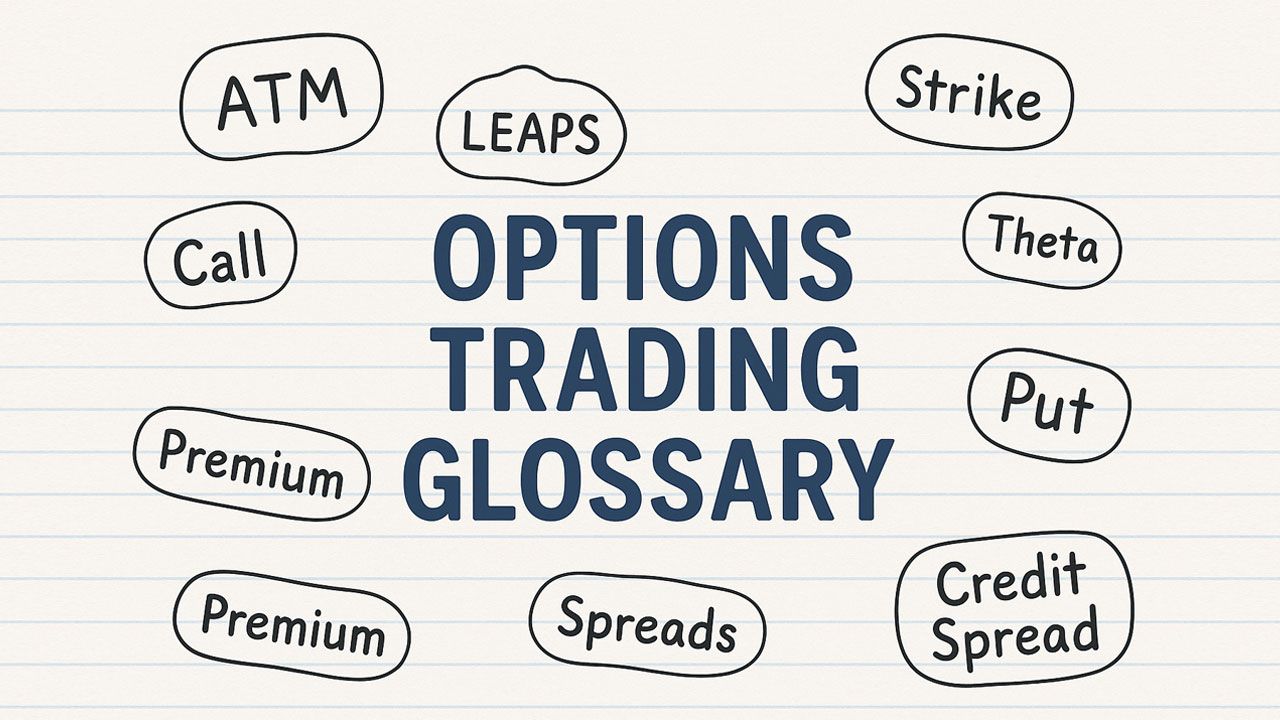Options Trading Glossary: Essential Terms Every Trader Should Know

Options trading comes with its own language. If you're new to trading, hearing phrases like theta decay, credit spreads, or implied volatility can feel like learning a foreign tongue. Even experienced traders keep a glossary nearby, because options terminology is both precise and nuanced.
This Options Trading Glossary is designed to be your quick-reference guide. Whether you're learning the basics or sharpening your edge, these definitions will help you navigate strategies, orders, and risk more confidently.
A-C: Foundational Concepts
Adjustments
Changes to contract terms following corporate actions, such as mergers or stock splits. For example, after a 3-for-2 split, one contract might represent 150 shares, not 100.
American vs. European Options
American options can be exercised at any time before expiration. European options can only be exercised on expiration day.
Ask Price / Bid Price / Bid-Ask Spread
⚡ Ask is the lowest price a seller will accept.
⚡ Bid is the highest price a buyer will pay.
⚡ Spread is the difference between the two. Tighter spreads generally mean better liquidity.
Assignment & Assignment Risk
When the buyer of an option exercises, the seller gets assigned. For call writers, this means selling the stock at the strike price; for put writers, it means buying it. Assignment risk increases near expiration.
Butterfly & Calendar Spreads
Popular multi-leg strategies:
⚡ Butterfly spreads combine bull and bear spreads with limited risk and reward.
⚡ Calendar spreads involve selling short-term options and buying longer-term options at the same strike price….
D-F: Key Metrics and Order Types
Delta & Gamma
Delta measures how much an option price moves with a $1 change in the underlying. Gamma shows how much Delta itself will change with that $1 move. Together, they're critical for understanding directional risk.
Debit vs. Credit
✅ Debit means paying to open a trade (e.g., buying a call).
✅ Credit means receiving money to open (e.g., selling a put).
Defined vs. Undefined Risk
✅ Defined risk strategies (like vertical spreads) have limited downside.
✅ Undefined risk trades (like naked calls) can lead to unlimited losses.
Fill-or-Kill (FOK) & All-or-None (AON) Orders
Special order types to control execution. FOK cancels immediately if not fully filled; AON waits until all contracts can be filled.
Fundamental Analysis
Evaluating a stock based on financials and economic data, as opposed to technical chart analysis.
G-I: Greeks and Volatility
Gamma
Shows how much Delta changes per $1 move. High Gamma means Delta can shift quickly, making positions more sensitive to price movement.
GTC & GTD Orders
Good-Til-Cancel (GTC) stays open until filled or canceled. Good-Til-Date (GTD) expires on a specific date.
Hedging
Using options to protect existing positions from losses, such as buying puts on stock you own.
Implied Volatility (IV)
The market's forecast of future volatility. Higher IV typically means higher option premiums. IV Rank compares today's IV to its historical range to help decide strategy selection.
J-P: Strategies, Premiums, and Payoffs
LEAPS
Long-term equity anticipation securities-options expiring more than a year out. Useful for longer-term strategies with less time decay.
Liquidity
A liquid options chain has high volume and tight bid-ask spreads. Illiquid options are harder to enter and exit efficiently.
Married Put / Covered Call
Classic protective strategies:
⚡ Married Put: Buy stock and a protective put simultaneously.
⚡ Covered Call: Own stock and sell a call against it to collect premium.
Open Interest
The number of active contracts that haven't been closed or exercised. High open interest often signals deeper, more liquid markets.
Payoff Diagram
Graph showing how a strategy performs at different stock prices at expiration. Useful for visualizing max profit, max loss, and breakeven points.
Premium
The price paid (debit) or received (credit) for an options contract.
Q-Z: Advanced Terms
Ratio Spreads & Ratio Writes
Strategies where more contracts are sold than bought, creating net credit and directional exposure.
Resistance & Support
Key levels in technical analysis. Support is where price may stop falling; Resistance is where it may stop rising.
Synthetic Positions
Using options to replicate stock behavior:
⚡ Long call + short put = synthetic long stock
⚡ Long put + short call = synthetic short stock
Theta (Time Decay)
Measures how much value an option loses with each passing day. All else equal, short option positions gain from time decay, while long option positions lose value as expiration approaches.
Vega
Shows how sensitive an option's price is to a 1% change in implied volatility.
Volatility Skew
Describes differences in implied volatility across strikes or expirations for the same underlying.
How to Use This Options Trading Glossary
- Keep It Handy While Learning
Print or bookmark this glossary as you go through strategies and trade setups.
- Don't Memorize-Reference
You'll absorb these terms naturally through repetition and use.
- Combine With Practice
The best way to master options language is by applying it to real or paper trades and seeing how Delta, Vega, or spreads behave in the market, cementing understanding.
Final Thoughts
Mastering the language of options is a critical step toward becoming a confident trader. This Options Trading Glossary should serve as your reference point whether you're learning how to sell cash-secured puts, structure an iron condor, or manage risk on complex spreads.
The more fluent you become, the easier it is to spot trading opportunities, communicate with other traders, and execute strategies with precision.
Stay Connected!
Join our mailing list to get notified of all new blog posts, and receive the latest news and updates from our team.

